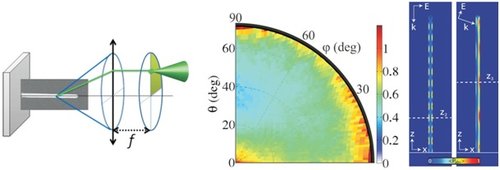May 28, 2014
Researchers at the FOM Institute AMOLF, CSIC (Spain) and the Eindhoven University of Technology introduced a technique that enables the measurement of the angle-dependent light absorption in dilute arrays of uncoupled semiconductor nanowires.
Semiconductor nanowires have attracted broad interest as building blocks for novel photodetectors and photovoltaic devices. Nanowires have proven to efficiently concentrate light and enhance absorption. Moreover, this absorption can be tuned by modifying the nanowire geometry making them act as nanoantennas for light. Despite extensive theoretical and experimental investigations on light absorption in nanowire arrays and in solar cells, the angle-dependent light absorption in individual nanowires remains largely unexplored.
Researchers at the FOM Institute AMOLF, CSIC (Spain) and the Eindhoven University of Technology have introduced a technique named time-reversed Fourier microscopy that enables the measurement of the angle-dependent light absorption in dilute arrays of uncoupled semiconductor nanowires. Because of their large separation, the nanowires have a response that can be described in terms of individual nanostructures. With time-reversed Fourier microscopy the researchers illuminates the nanowires under a microscope objective with a well defined angle of incidence. This angle can be varied by scanning a laser beam.
The geometry of individual nanowires makes them behave as nanoantennas that show a strong interaction with the incident light. The angle-dependent measurements show the transition from absorption at incidence along the nanowire axis due to coupling of the incident light to guided waves in the cylindrical structure defined by the nanowires to absorption due to scattering as the light is incident perpendicular to the wires. The researchers have found that a maximum absorption is obtained for small angles of incidence relative to the nanowire axis. These findings are relevant for the design of nanowire-based photodetectors and solar cells with an optimum efficiency.
The results of this research are published as ASAP online article of Nano Letters on 8 May, 2014.
Reference
Grzegorz Grzela, Ramon Paniagua-Domínguez, Tommy Barten, Dick van Dam, Jose A. Sánchez-Gil, and Jaime Gómez Rivas
Nanowire Antenna Absorption Probed with Time-Reversed Fourier Microscopy
Nano Letters, article ASAP, 8 May 2014 | DOI: dx.doi.org/10.1021/nl5005948















